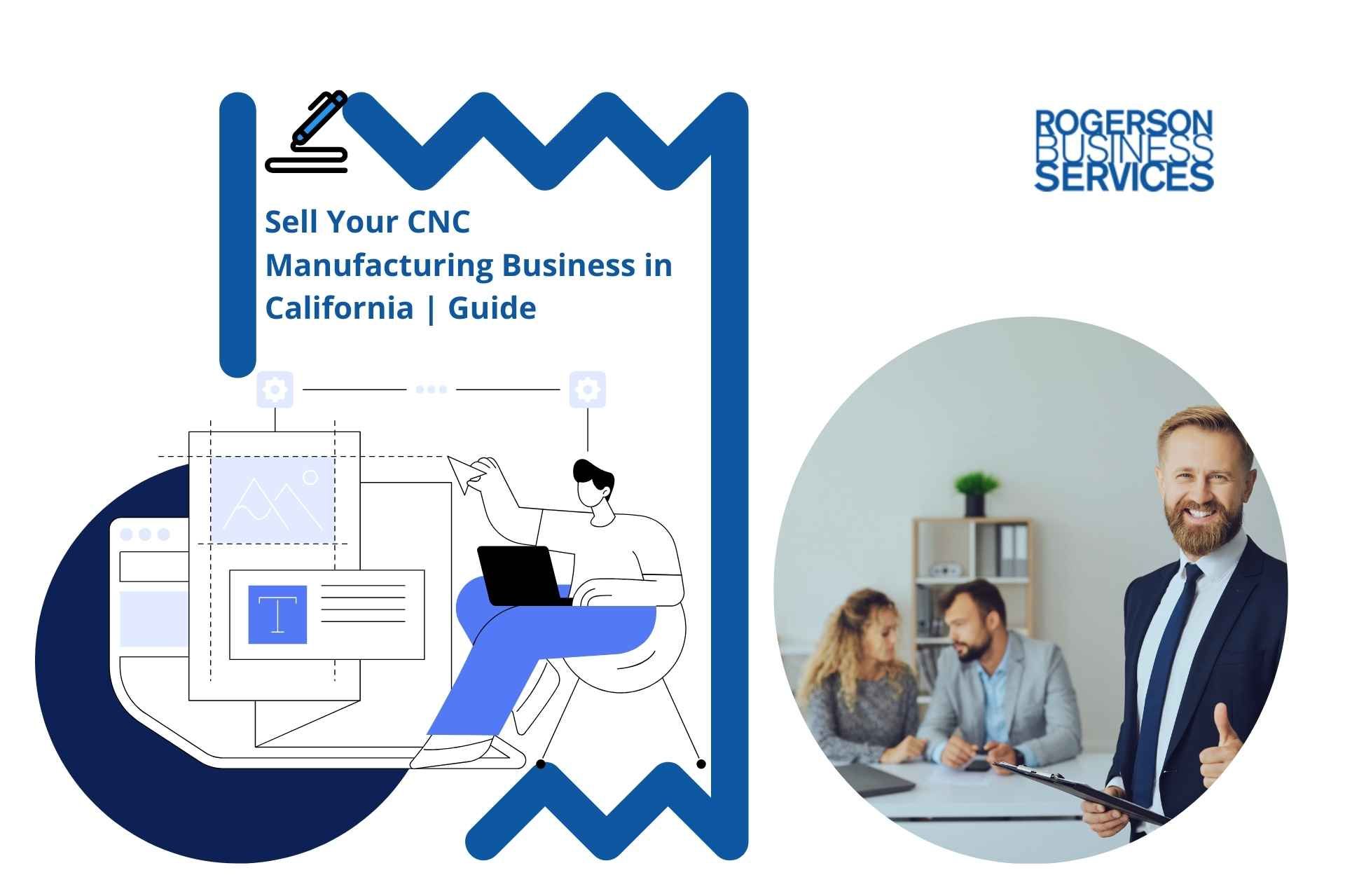How to Sell My Business in California & Get Good Price
Sell my business

Whether you’re looking for a new business opportunity, looking to accomplish new goals, or a Baby Boomer looking to retire, you’ve decided to sell your business.
You’ve spent a lot of time, money, and hard work establishing your business, and now you’re looking to get maximum value from your brand.
There are various factors involved in the selling of a business. It’s imperative to follow an organized process, such as
knowing the value of your business, having a clear understanding of a possible buyer’s suitability before you sit down to discuss terms, knowing the company’s competitive position in the market and more.
Successfully
selling your business
requires proper planning—from organizing financial statements to making sure the business presents as positively as possible to potential buyers.
As you approach the sale of your business, look at things not only from your perspective as the seller, but equally important, through the eyes of a buyer. One of the fastest ways a company expands is through mergers and acquisitions or an M&A transaction.
According to PitchBook, the vast majority of M&A transactions are with companies from the lower-middle market or worth under $100 million.
The number of middle-market businesses for sale only continues to grow.
In 2016’s second quarter, over 70% of deals were closed with lower-middle market companies.
Over the past few years, there’s been a particular attraction to smaller businesses since they’re far easier to find and integrate.
There are also several exit strategies when it comes to selling your business, but we've narrowed down the process to 8 steps:
- Find out how much your business is worth
- Ensure your financial statements are up to date and accurate with your CPA or Accountant.
- Find a broker or M&A Advisor.
- Create a management summary of your business
- Market your business
- Receive and negotiate offers from prospective buyers
- Make sure all legal documents are prepared by a qualified legal advisor
- Resolve and close the deal
While there’s still a lot that goes on in between each step, selling your business largely depends on the
business type.
So, if you’ve been asking, “how do I sell my business,” you’ve come to the right place. In this article, we’ll go through tips, and helpful steps to sell your business for the highest value.
Choosing Your Business Exit Strategy
Choosing an exit plan is just as important as any step in the selling process. The route which you decide to take may determine business development decisions.
Many factors determine which
business exit strategy framework
an entrepreneur chooses, such as how involved they (the owner) want to keep in the business, whether they’re willing to see the company shift directions, or whether they want the new owners and their executive team run the company in the same manner after their departure.
Business exit strategy planning
also depends on the business gross revenue, industry the business is in, what’s happening in the local, regional, state and national economy. For instance, a practice in the medical field might benefit from selling to another practice in the same discipline.
On the other hand, an owner’s unusual exit strategy may just be to make as much money as possible, then shut down the business. Yes - unusual - but it does happen - thankfully not too often.
If the business has two or three partners, each parties’ interests must be considered.
Valuations: How to Sell My Business for the Best Price
A business valuation is a step by step process of arriving at the economic value of a business.
How to Calculate the value of a business
There are many different ways in which a company is valued. Below, you can learn about several of these valuation approaches.
1. Market Capitalization
When it comes to calculating business valuation, many business owners view market capitalization as the most straightforward method. Market capitalization works by multiplying the total number of shares outstanding by the company’s share price.
In simple terms, market capitalization is how much a company is worth according to the stock market of a publicly traded business. As we are dealing with a business that is privately held, the Market Capitalization rate is not used
2. Earnings Multiplier
Another valuation calculation is the earnings multiplier method. Compared to sales revenue, a business’s Net Income or profit serves as a more reliable indicator of its value as it reflects what the owner gets to keep after all expenses.
To help with this concept, would you pay more for a business with $10 million in gross revenue and costs $12 million to operate or a business with $10 million in gross revenue and costs $5 million to operate?
3. Times Revenue
The times revenue method uses current revenues to determine the maximum value for a business. However, this specific method isn’t always reliable when it comes to business valuation as we showed in the illustration above in the Earnings Multiplier method.
Valuing a firm based on revenue isn’t the same thing as valuing a firm based on profit, and an increase in revenue doesn’t always convert to profit growth.
4. Discounted Cash Flow
The discounted cash flow, or DCF method of business valuation, bases its value on its projected cash flows, adjusted to attain the business’s ongoing market value. This method also considers inflation when calculating value.
5. Tally the value of assets
This valuation method calculates the total value of everything the business owns, like inventory and equipment. It then deducts any existing liabilities or debts. The value you get from this can serve as a starting point for ascertaining the business’s worth.
However, a business is most likely worth more than its assets so use this valuation method carefully.
Tips to Prepare Your Business for Sale
Below are some steps on how to prepare to value and then sell your business.
1. Obtain a business valuation.
First and foremost, you should secure a realistic idea of what your business is worth from an unbiased source. Obtaining a professional evaluation will establish a foundation for measuring future offers. It also gives you a general picture of what you can expect to get from the sale.
Varying from local accounting firms to lower middle market business brokers to investment banking firms, you can get a professional valuation from numerous sources.
2. Arrange your financial statements.
When a buyer evaluates your business, they’ll typically require at least three years' worth of financial statements including tax returns.
The more organized and well-ordered your financial statements, the more comfortable you'll make the buyer and their
team of advisors.
3. Understand your business’s true Net Income or Seller’s Discretionary Earnings.
As part of a buyer’s Due Diligence when buying a privately held business, they can request any document they need so they can test and be comfortable with the accuracy of the financial statements
4. Discuss matters with your financial advisor.
You may also want to speak to your financial or tax advisor to help plan the future for your finances and the necessary taxes to pay when you sell your business. Having an adequate understanding of your tax situation—both corporate and personal—may help point out any viable options regarding deal structure.
5. Sort out your legal paperwork.
Make sure to go over associated permits, leases, licensing agreements, vendor and customer contracts, and any other related papers. When it comes time to meet with potential buyers, have the documents needed to sell a business readily available and in order. This applies especially when you are buying a business in California as there are license requirements and more to own and operate most businesses in California.
6. Get your advisory team in place.
Begin conducting interviews with accountants and attorneys who are skilled in mergers and acquisitions. You may also want to consider hiring an M&A Advisor. Their role is to help correctly value the business and lead the transaction to source potential buyers and assist you, as the owner of the business, in the selling process.
Conclusion
While we’ve presented plenty of helpful tips on how to sell your business, contacting an M&A Advisor, middle-market business brokers, or preparing an M&A strategy can be the difference between selling your business and almost selling your business. It is estimated that only 25% of privately held businesses actually sell. Increase your odds by getting a professional advisor to assist you.
Mergers and acquisitions (M&A) simply refers to a bigger company taking over a smaller one. Examples of an
M&A exit strategy
include:
- The buyer needs a product or service promptly.
- Several buyers may bid against each other, elevating your business’ value.
- You’re more likely to negotiate a higher price when you sell to a competitor as opposed to an outside party.
Additionally, using an
M&A Advisor can help give you a competitive edge in the market and eliminate or reduce friction points or road blocks in the selling process.
Hiring an M&A advisory firm can go a long way in helping you create an extensive market for your company. An M&A broker also provides you with all the information you need, including how much taxes you have to pay during the selling process.
If you are a retiring business owner looking to exit your lower middle market business in California, here are five tips to get you started:
1. Don't wait until the last minute to start planning your exit. The process of selling a lower middle market business can take a long time, so it's important to start early.
2. Have a clear idea of what you want to get out of the sale. Know your goals and what you're willing to negotiate.
3. Choose the right type of buyer. Not all buyers are created equal, so do your research and find the right one for your business.
4. Be prepared for a lot of due diligence. M&A buy-side due diligence is when buyers will want to know everything about your business, so be ready to provide documentation and answer questions.
5. Be flexible with the terms and conditions of the deal. It's important to be open to negotiation to get the best possible deal for your business.
Rogerson Business Services, also known as, California's lower middle market business broker is a sell-side M&A advisory firm that has closed hundreds of lower middle-market deals in California. We are dedicated to helping our clients maximize value and achieve their desired outcomes.
We have a deep understanding of the Californian market and an extensive network of buyers, which allows us to get the best possible price for our clients. We also provide comprehensive support throughout the entire process, from initial valuation to post-closing integration.
Our hands-on approach and commitment to our client's success set us apart from other firms in the industry. If you consider selling your lower middle market business, we would be honored to help you navigate the process and realize your goals.
If you have decided to value and then sell your lower middle market business or still not ready, get started here, or call toll-free 1-844-414-9600and leave a voice message with your question and get it answered within 24 hours. The deal team is spearheaded by Andrew Rogerson, Certified M&A Advisor, he will personally review and understand your pain point/s and prioritize your inquiry with Rogerson Business Services,
RBS Advisors.
Hey there! Can we send you a gift?
We just wanted to say hi and thanks for stopping by our little corner of the web. :) we'd love to offer you a cup of coffee/tea, but, alas, this is the Internet.
However, we think you'll love our email newsletter about building value and properly position your company before transition/exit your business ownership.
As a special welcome gift for subscribing, you'll also get our helping and educational guides, tips, tutorials, etc.. for free.
It's filled with the best practices for retiring serial business owners like Dan Gilbert, Larry Ellison, Warren Buffett, and many more.
Just sign up for our emails below.


